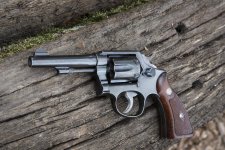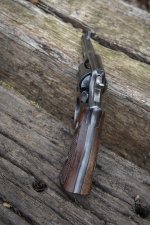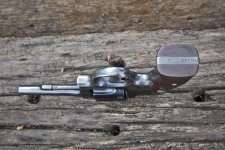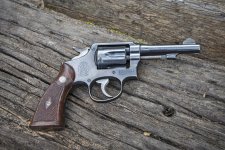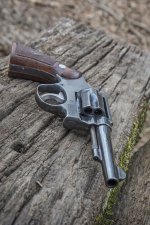I've been collecting guns for about forty years, but only recently got the S&W revolver bug. I enjoy finding guns that have not been given a lot of love, but have been well-used. Part of that stems from the fact that I'm cheap, but more so because of the fact that I enjoy cleaning, polishing, restoring, slicking-up, and replacing incorrect or worn parts.
I picked up this 1953-vintage (I think) M&P .38 Special a couple of months back. It had light rust and freckling, hadn't been cleaned in forever, and was wearing some incorrect target stocks. After some boiling and carding, a Wilson spring kit, and the correct (almost?) stocks, she is once again a nice, little wheelgun.
She shot pretty well before I did all the work. Now that I'm thru, she has a sweet 2.5 lb. SA pull and I haven't measured the DA pull, but it's smooth as butter. She locks up tighter and has less end shake than new models. She is worn just enough so that I won't be afraid to shoot her.
Now, I'm on to find my next victim.
I picked up this 1953-vintage (I think) M&P .38 Special a couple of months back. It had light rust and freckling, hadn't been cleaned in forever, and was wearing some incorrect target stocks. After some boiling and carding, a Wilson spring kit, and the correct (almost?) stocks, she is once again a nice, little wheelgun.
She shot pretty well before I did all the work. Now that I'm thru, she has a sweet 2.5 lb. SA pull and I haven't measured the DA pull, but it's smooth as butter. She locks up tighter and has less end shake than new models. She is worn just enough so that I won't be afraid to shoot her.
Now, I'm on to find my next victim.

